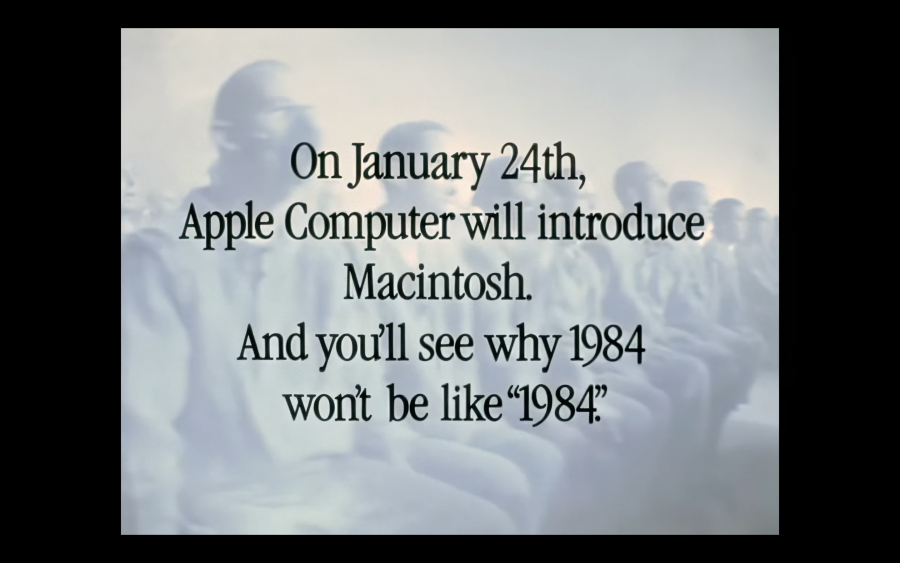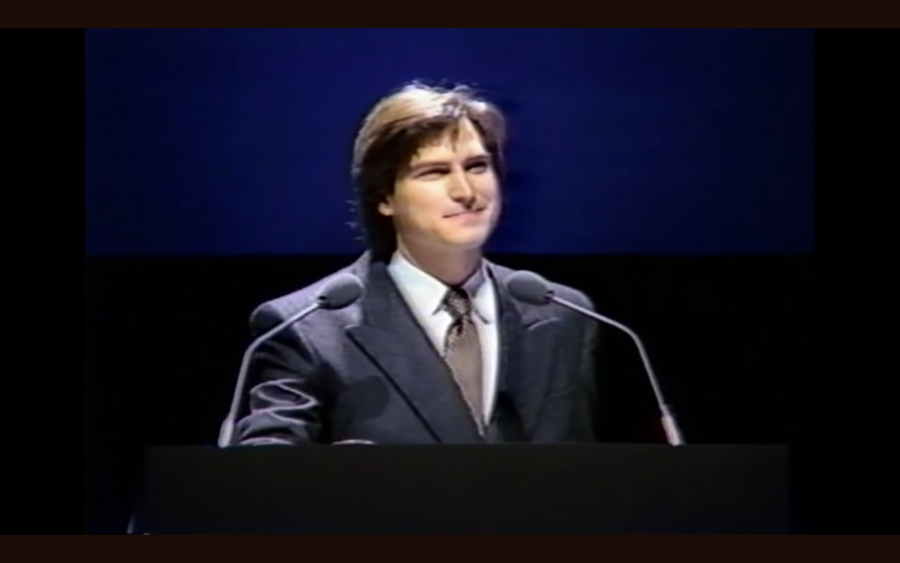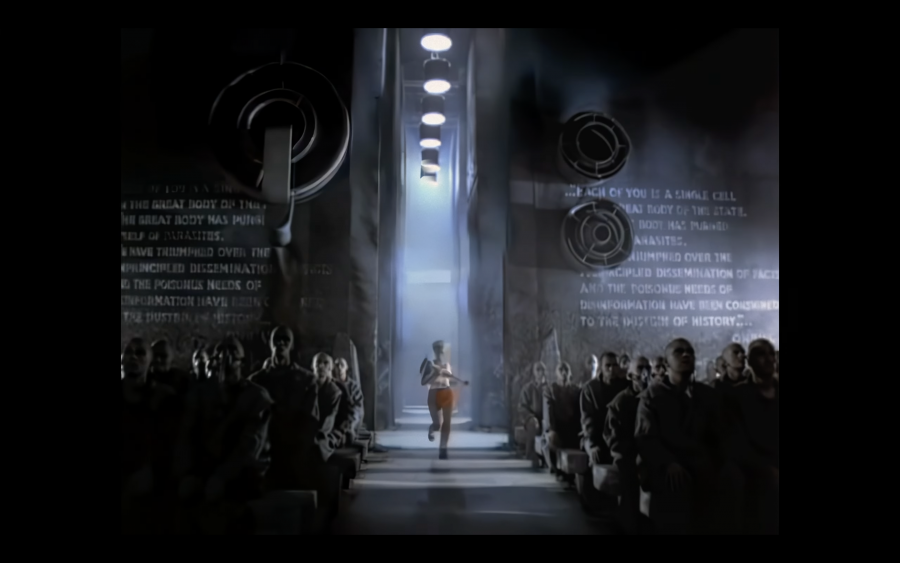
Freedom is slavery: Apple’s 1984 Ad Forty Years On
The one-minute ad opens with skinheads - actual skinheads recruited as extras, according to production lore - walking in lockstep through a tube-like passageway lined with screens in some dystopian metropolis. It is shot in colour but starts with a monochrome palette: dull grey with a soundtrack of industrial noise and a voice over a loudspeaker talking about ‘information purification’. About ten seconds in there is a flash of bright red: a blonde woman in a white top and red shorts is running with a sledgehammer. Cut back to the line of men (they are noticeably all men): one is wearing a sort of Hannibal Lecter gimp mask. There are riot police with helmets and truncheons, and the sound of marching boots. Then the woman running again, getting closer to something. Cut to a large hall and a looming telescreen showing the face of the dictator whose voice has been droning on since the beginning about ‘a garden of pure ideology’. We don’t like him. The woman with the sledgehammer enters the hall - our saviour!
Still we’re only halfway through. Rows of men in grey are seated now, listening obediently to the screen. Boo. But wait! Pursued by riot police the woman approaches, and slows her pace: what is she going to do with that big hammer? She starts swinging the sledgehammer like an Olympian, round and round, gathering force. She lets it go with a loud ‘hyahhh!’ The hammer flies through the air and strikes the centre of the screen just as the face intones: ‘We shall prevail.’ Not so fast, pal! As the screen explodes in a flash of light and the winds of change howl, the ‘good’ voiceover breaks in and promises that, with Apple’s help, ‘1984 won’t be like “1984”.’ Close on the rainbow apple logo.

A screenshot from Apple’s "1984" television commercial with the text: “On Januari 24th, Apple Computer will introduce Macintosh. And you’ll see why 1984 won’t be like “1984”.”
I’m old enough to remember watching this famous ad on TV as a kid. My dad and I were watching the Super Bowl: the Los Angeles Raiders walloped the (now renamed) Washington Redskins 38-9. Unfortunately it was a black-and-white TV so I missed the essential colour component, but I still remember the impression it made. In fact the Super Bowl was the only time it aired to a wide audience. It’s hard to conceive of now, but you couldn’t watch the clip anywhere after that: no repeat broadcasts and no copies, apart from still images or personal VHS recordings (because a lot of people were taping the Super Bowl). Imagine one of the most shareable clips you’ve ever seen … and now imagine seeing it only once. Imagine not being able to share it except by describing what you saw to those poor souls who missed it and imagine the power of a company that had almost total control of that clip, so that it really was shown only once.
Producing the Apple ad
The woman who starred in the ad, Anya Major, was a champion English discus thrower: excitement was building before the 1984 Los Angeles Summer Olympics (although women did not participate in the hammer throw until the 2000 Olympics). Significantly, the athlete is also a runner - a hugely popular sport at the time, especially in California. The sledgehammer is an image of disruption: move fast and break things, tear down the old grey corporate world. The battle was IBM vs Apple, with Apple portraying itself as the underdog, the challenger. IBM had long downplayed the role ‘mini’ computers would play in the future (oops!), until it finally followed Apple into the market in 1981 with the IBM PC. Computers still had a corporate image; IBM of course stands for International Business Machines. Apple’s radical promise was that computers would be personal, domesticated, stylish accessories - not just for businessmen in suits but for … women! Everyone! The budget for the ad was reported to be nearly a million dollars, which was unheard of at the time. The British director Ridley Scott, known at the time for Alien (1979) and Blade Runner (1982), was the perfect choice for creating a cool dystopian ad on an epic scale. (It bears some resemblance to Michael Radford’s 1984 adaptation of Orwell’s novel, which was in production at the time and came out later that year with a soundtrack by Eurythmics.)
The ad strikes me as weirdly ironic: a techno-dystopian future where Silicon Valley is the solution rather than the problem, like Black Mirror in reverse.
Even though I was only twelve, I got the Orwell reference. My parents had prepared me for the much-anticipated arrival of the year Orwell prophesied in 1948. I even had a black pin with the year 1984 on it that I wore around school like the young goth I was (I still have it somewhere). After the shaggy excesses of the sixties and seventies, the 1980s felt sleek and modern: hair that defied gravity, synthesisers, shopping malls, and the looming threat of a nuclear apocalypse. Computers played a central role in this futuristic imaginary, even if they had about as much memory as a Tamagotchi and couldn’t offer much besides word processing and games of Pong. But all that was about to change! Looking at it now, the ad strikes me as weirdly ironic: a techno-dystopian future where Silicon Valley is the solution rather than the problem, like Black Mirror in reverse.
As is so often the case in advertising, especially related to new technologies, what Apple promised was not a specific product but a vision of the future - an exciting, sexy, progressive, liberating future. A week after the Super Bowl, on January 30, Steve Jobs introduced the Macintosh at a landmark event and showed the ad again. He set up the David-and-Goliath narrative, with Apple as ‘the only hope for freedom’, in a clever, tongue-in-cheek speech that drew laughter from the crowd. Apple was the cool Californian computer company, and Steve Jobs (with hair) looked a bit like Tom Cruise in Risky Business (1983). He played the ad to rapturous applause and promised the new Macintosh was ‘insanely great’. Apple still sells itself as the solution to government interference and privacy issues, and as the design-forward rival to boring PCs. The ad argues for the power of the individual computer user, and by extension for grassroots networks; similar to the way Twitter was portrayed in its early days as a tool for organising against oppressive authority. In 2024, however, the techno-utopianism of Apple’s message might ring less true than the dystopian vision that the woman wielding the hammer seeks to overthrow.

A screenshot from the Apple Macintosh premiere with Steve Jobs on January 30, 1984.
Independence and optimism for the future
The optimism the ad represents - vanquishing the darkness, freedom from Big Brother - reached a high point a decade later in John Perry Barlow’s manifesto ‘A Declaration of the Independence of Cyberspace’ (1996): ‘I declare the global social space we are building to be naturally independent of the tyrannies you seek to impose on us.’ This kind of optimism continued more or less unabated for another two decades, until around 2014 or 2015, when questioning the value of ubiquitous computing and social media started to gain a foothold in the mainstream. (As evidence of this shift in the zeitgeist, around this time I co-authored a blog called Crap Futures.) Not that techno-solutionism is dead: just look at Marc Andreesen’s ‘Techno-Optimist Manifesto’ (2023), which breathlessly references F. T. Marinetti’s ‘Manifesto of Futurism’ (1909) alongside the free-market economist Milton Friedman and the accelerationist Nick Land. But as the MIT professor Joseph Weizenbaum said at the time: ‘The ad seems to say the remedy to too much technology is more technology. It’s like selling someone a pistol to defend himself in the event of nuclear war.’
‘The ad seems to say the remedy to too much technology is more technology. It’s like selling someone a pistol to defend himself in the event of nuclear war.’
The voices of warning and dissent were, in fact, there all along to anyone who would listen, like Neil Postman’s Amusing Ourselves to Death (1985) or Richard Barbrook and Andy Cameron’s prescient critique ‘The Californian Ideology’ (1995). In the latter essay Barbrook and Cameron contrast the new ideology, which ‘combines the free-wheeling spirit of the hippies and the entrepreneurial zeal of the yuppies’, with a reminder of the true retrograde nature of Silicon Valley and California itself - that it is built on racism, inequality, and destruction of the environment:
Across the world, the Californian Ideology has been embraced as an optimistic and emancipatory form of technological determinism. Yet, this utopian fantasy of the West Coast depends upon its blindness towards - and dependence on - the social and racial polarisation of the society from which it was born. Despite its radical rhetoric, the Californian Ideology is ultimately pessimistic about real social change. […] Reflecting its deep ambiguity, the Californian Ideology's technological determinism is not simply optimistic and emancipatory. It is simultaneously a deeply pessimistic and repressive vision of the future.

A screenshot from Apple’s "1984" television commercial.
Technology as a solution?
In the ad, Apple seems to want to do more than just sell a product - it wants to save the world. But Apple’s promise was always a hollow one. As the art director, Brent Thomas, told the New York Times in 1984: ‘We did not say the computer will set us free - I have no idea how it will work out. This was strictly a marketing position.’
Four decades later, in the unimaginably futuristic-sounding year 2024, what is truth and what is fiction? How do we fight the capitalist realism that tells us the solution to oppressive technology is yet more technology? Where does the true dystopia lie, and who will bring it crashing down?